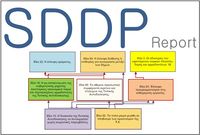Insafe SDDP: Achieving Max Media with Minimum Budget - Defining an Action Plan
|
Part of Getting the Best out of our Insafe Network 2007 Co-Laboratories.
Executive Summary
The SDDP co-laboratory Achieving Max Media With Minimum Budget documented here built on experiences gained from previous relevant training sessions in Bruges and Stockholm as well as the results of the 6-month evaluations (Customer Satisfaction Surveys) performed by the coordinating node.
The co-laboratory was dealing with sharing and developing ideas, projects, initiatives, and methods to achieve maximum media impact with limited budget. Participants collected and exchanged as much information and knowledge as possible to be used accordingly by the nodes so as to achieve as much media exposure as possible at the lowest possible cost to define an action plan.
On the 18th of September 2007, staff of the European network of Safer Internet Nodes engaged at St. Raphael Hotel, Limassol, Cyprus, for three hours in a structured dialogue focusing on the triggering question:
What ideas and actions can nodes do to materialize achieving max media with limited budget?
Insafe nodes’ staff described 82 ideas and actions ahead of the co-laboratory and during the dialogue with the entire group. The participants altogether grouped these 82 ideas and actions into six categories based on common attributes among the ideas identified by the Nodes’ staff. These categories were named the following:
- Insafe Network
- Cooperation Organization
- Practical Tips
- Online Strategies
- Message Creation
- Communication Skills
Each participant chose five ideas that they thought were the most important. The voting results were used to select ideas for the subsequent structuring phase to identify inter-relations among the generated ideas.
The 10 ideas were structured within four levels and are related according to the influence they exert on each other. Those ideas that appear lower in the Influence Map, are more influential in terms of influence than those at higher levels and are the ones to tackle preferentially.
According to the participants of this workshop, the obstacle appear to be the most influential was:
Action #64: Exchange of good practice
After having participated in the structured dialogue it was expected that:
- Participants would gain a deeper understanding of the complexity of the situation and the interconnections between “ideas”;
- Participants would have the opportunity to understand how the “others” may think or perceive the current situation or envision the “ideal” situation;
- A “voted” consensus between all participants taking part in the co-laboratory would emerge in the “influence tree” as a joint product.
The Facilitation Team of this co-laboratory consisted of: Ilke Dagli, Elia Petridou and Kerstin Wittig.
Participants
| Name | Country |
|---|---|
| Daniela Agius | Malta |
| Claudia Ceccarelli | Italy |
| Marjolijn Durinck | Netherlands |
| Lena Fagerström | Sweden |
| Gry Hasselbalch | Denmark |
| Ronald Hechenberger | Austria |
| Karl Hopwood | UK |
| Gudberg Jonsson | Iceland |
| Liene Kalna | Latvia |
| Stephanie Kutscher | Germany |
| Karin Larsson | Sweden |
| Stian Lindbol | Norway |
| Maria Elisa Marzotti | Italy |
| Juuso Peura | Finland |
| Luca Pitolli | Italy |
| Teemu Ruohonen | Finland |
| Anna Rywczynska | Poland |
| Veronica Samara | Greece |
| Ellen Stassart | Belgium |
| Jason Steele | UK |
| Judith Swietlik-Simon | Luxembourg |
| Tom Van Renterghem | Belgium |
| Gráinne Walsh | Ireland |
| Agnieszka Wrzesien | Poland |
| José Luis Zatarain | Spain |
| Alenka Žavbi | Slovenia |
